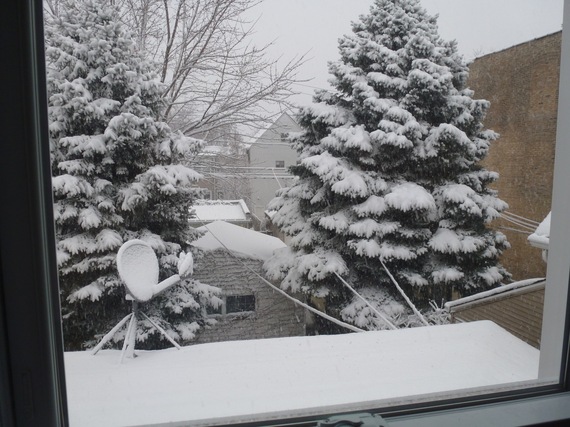This is Chicago. Where the cold grey October rain pounds streets soaked in blood. We kill people here. And we do it a lot. Giggling babies in their beds snuffed out by stray bullets pinging through the walls. Tired old working men on their front stoops taking a well deserved rest, slapped down by a 12 year old with no clue till this moment that firing an assault rifle ain't like T.V. The old man's blood dripping down the front porch steps he'd kept painted now for 40 years.
This is Chicago where a cloud like a tired and angry October sky is slapping the city into the darkest horror of them all: the belief that all this killing happens somewhere else. That it's not in my neighborhood. Not my problem. It is something that just happens to those other kinds of people. The killing is somewhere on the other side of a wall that some slick talking bully says he will build for us. Selling protection the same way it's always been sold. "Gimme some cash Mister Store Keep. Gimme some cash or maybe just vote for me and your store won't burn down"
This is Chicago where the killing and the blood and rain all stream together with a river of talk. So what am I doing, being sad about a tree?
There it is on the right. It's twin tree in our yard on the left. A pair of towering Christmas trees all year long. Pine needle protection. Home base to an ongoing chattering, busy, buzzy bird song that would always be there to welcome us home. Migratory birds to mark the changing of the seasons. Once a flock of Chicago's famed Wild Canaries fluttered in for a visit. Darting yellow sparkles doing the business of joy.
Presiding over all this like gentle monarchs was the mourning dove couple we named Patrick and Louisa. Keeping watch across our fourteen years and still counting in the house. Their home was the tree, their descendants carrying on forward. Their ancestors going back to another Chicago. The house is over 100 years old. The tree was there for a good many of those years. As was the spirit of the mourning doves. Patrick and Louisa.
Till one day we all came home and the tree was gone.
The neighbor took it down. No clue why. We don't talk much. And it was his tree. As much as a tree can belong to anyone. I can't believe the tree was ready to die.
The list of bigger problems than the disappearing tree is too long to count. But the void. The shivering grey emptiness where the tree used to be---that strikes a familiar chord. It's the same sick feeling in your stomach that you get when you hear that the blood street killing in Chicago is someone else's problem. Someone else's fault.
It's all the same void.
There is a void now where the connection between the people used to be.
We still cry for babies or dying trees. But only in our neighborhood. Only in our yard.
Make no mistake, Chicago has never lacked for stone cold brutal segregation. Whether it's rolling out expressways that divide neighborhoods, building towers that stack the vulnerable on top of each other, redlining like Papa Trump or a million moments of a child learning the hard way that there are just streets upon which you just do not walk. Our sins have never been far away.
But the October wind this year carries a sickly sweet cold emptiness. The tree is gone. The killing goes on. The wind blows empty. The void grows wider. Deeper. That which connects us grows empty.
Empty like the intersection of Damen and Addison, just a few blocks away. Anastasia Kondrasheva, 23 and full of smiling, young life. Riding her bike to work at the Harken Health Center up in Edgewater. Her work as a Health Coach.
The traffic light changes. The truck makes a right turn. The driver doesn't see the bicyclist. The young girl dies.
The driver, physically unhurt but devastated by what just happened, is put in the ambulance and taken for treatment of an emotional wound that might never heal. The news goes out, at the Harken Health Center, where there is a work family, to friends and family, to the bicycling community, to all of Chicago. A memorial service is organized, and here we get a hint of what it will take to fill our common void, a service is organized for the corner of Damen and Addison, by people who never even knew Anastasia.
Three hundred people came to that service Friday night. The Chicago Police quietly diverting traffic while neighbors kneeled put down flowers and cried in the streetlight shadows. A "Ghost Bike," placed on the corner. Ghost bikes are painted white bicycles that serve to memorialize a spot where a bicyclist has died. Where maybe the void grew wider for those who chose to think, "What does the accident have to do with me?"
Or maybe the Ghost Bike could start us down another path. Prompt us to strengthen the connections between us. Offer up a set of guiding principals to help us fill the void where the tree, the young woman, where all of us touched by the ripples of the emptiness live our lives. Riding in on the ghost bike come five principles, like lights on the handlebars, to guide us on our common way:
1.Tell your story. Channel the power of every person's story. Never write a policy, make a plan or spend a dime unless you can name a person you will serve. Bring back the time when words mattered. Stories build highways and food pantries. Jobs and schools. Temples, mosques and churches.
2.Add Music. Find what flows between the facts. The fit. If you're going to curb violence, let the whole orchestra play.
3.Communitize. Make community a verb.
4.Solve a mystery. Honor the space where that tree grew even if you don't know why it's gone. For young Anastasia, figure out how to make bicycling safer.
5.Practice Stewardship. Take care of something larger than yourself.
At the corner of Addison and Damen, in the drizzling rains of October, the spokesperson for Anastasia's family said "This is everybody's problem."
Looking out my window to the gaping space where the tree used to be, I wonder how many believe that the killing rippling out to every corner of Chicago is everybody's problem.
I wonder if there is even one single person who will read the five principles, and ask the questions:
What if this were a path to the belief that the violence is everyone's problem?
What if we all saw ourselves standing in that river of blood?

